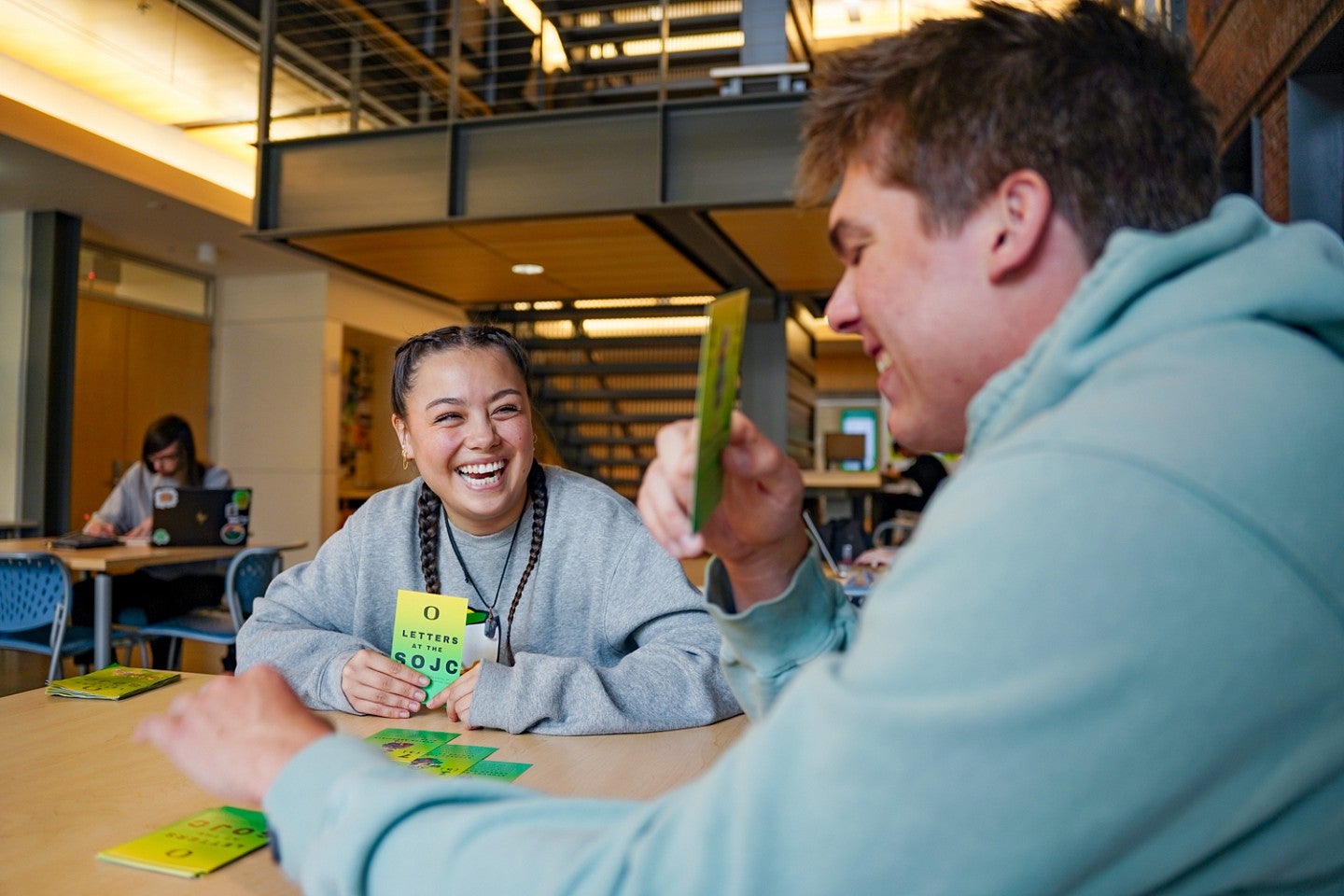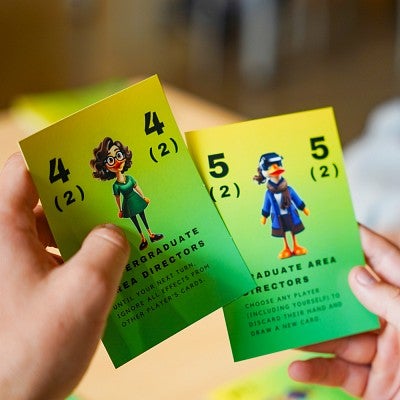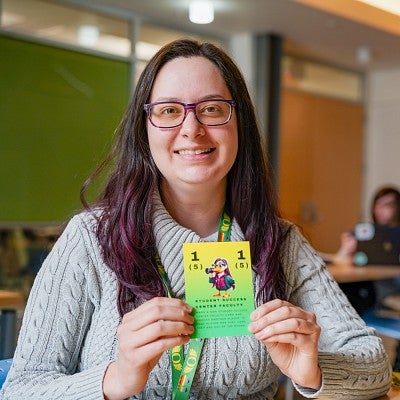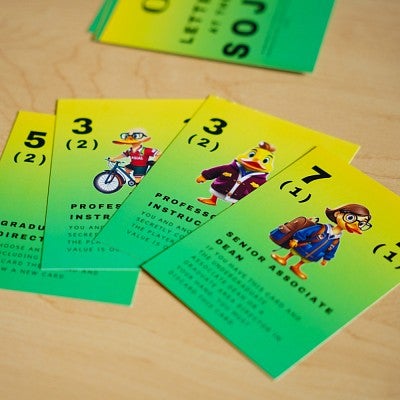
A documentary, a podcast, a pamphlet, a video game or maybe something else? These were some of the suggestions Assistant Professor Maxwell Foxman challenged my Media Studies Production class to create as a final project.
The goal was to think critically about a project from day one, asking key questions about who, why and what was the best way to create a socially and culturally meaningful production. The course exposed important lenses, concepts and theories to apply to the production of anything from a well-written article to an advertising campaign and even comics, theater and games.

Inspired by my favorite and most-played card game, Love Letter, I decided to recreate it. But my game — Letters at the SOJC — would be based on getting to know the people of the UO School of Journalism and Communications (SOJC). What better way to help students get acquainted with the SOJC community than to create a game.
Love Letter, designed by Seiji Kanai, is a deduction game with a 16-card deck. Players attempt to deliver their love letter to the princess while keeping other players’ letters away. Players start with one card, and on their turn, they draw one card and play one card, resolving its effects and trying to knock their opponents out of the round. For instance, one card allows the player to look at another players hand and another card enables the player to guess another player’s hand, knocking them out of the round if they guess correctly.
Letters at the SOJC is similar, but it invites players to navigate the interconnected SOJC community, revealing each staff or faculty member’s personality and expertise. Whether you're a newcomer eager to learn about your SOJC mentors or a current student looking to unwind before class, this game is a fun and informative portal into the school. At the end of the rule booklet, in the “About the Characters” section, players can find out fun facts about the staff and faculty members, when and how they got to the SOJC and who they consider their best friends in the SOJC.
Game is based on real SOJC faculty, staff
While Letters at the SOJC uses the same game mechanics and rules as Love Letter, it is a different narrative, with members of the SOJC faculty as the game’s characters.

In my game, you are an SOJC student trying to implement a change, sending a letter to the dean as fast and efficiently as possible with the help of SOJC faculty. Whoever gets their letter to the dean first wins. To do that, you need to be the last player remaining or the player with the highest card at the end of the round. This game can be played in one round or as many as you want.
To gather content for the game, I reached out to several SOJC faculty members and staff and asked them to answer some questions to become characters in the game. I used my conversations with them not only to create character biographies but also character illustrations.
Each faculty member shared their favorite colors to wear, what they usually carry with them, and their hobbies and interests to get enough details for a generative AI prompt. I wanted all the characters to be ducks resembling each game character. This entailed spending hours tweaking prompts on CapCut’s text-to-image AI generator. For example, I asked for one image to be a duck-billed caricature with brown hair who was carrying a phone and wearing glasses, a purple sweater and black pants.
Consider audience and design to create a game
Along with Media Studio Production (J250), I took Introduction to Studying Games, also with Assistant Professor Foxman, who is the director of the SOJC’s soon-to-be-launched game studies minor. I connected numerous concepts from the games class to my card game, such as game development, design, narrative, game effects and hegemony of play.
This was especially helpful because in J250, we learned how important it is to bring theoretical and critical underpinnings not only to what we consume, but also to what we produce. As a producer, it’s your responsibility to think about audience reception, representation and the effects the production may have on consumers.
Each media project students created had certain ideological theories it was built upon: feminism, postcolonial theory, self-reflexive measures, etc. Through a series of deliverables and class discussions, we planned production, made theoretical decisions, created a production schedule and more to keep us on track with our projects, and we workshopped it along the way to get feedback.

Game connects to community
As for representation and reception, I wanted to ensure my game represented the SOJC as a close-knit community, almost like a family, which is how many students, alumni and faculty describe it. To create an accurate depiction of how the SOJC runs, I showcased the SOJC administration but also featured other SOJC leaders, staff and faculty who offer significant support to students. The SOJC wouldn’t be nearly as successful without all the amazing faculty and staff, and that’s what I hope my game shows.
One theoretical decision I made was to include disclaimers in the rule booklet to ensure the game is interpreted the way I intend. Since there is a card-ranking system in the game, one disclaimer states that the ranked system is merely for game mechanics, and everyone is equally valued at the SOJC. I also made a disclaimer about the lack of intersectional representation in the game and indicated that players should think of the illustrations simply as silly anthropomorphic ducks, not 100% accurate representations of the SOJC’s diversity.
Letters at the SOJC is more than just a project for class; it's a reflection of the SOJC’s commitment to community. I created it because I was inspired by the genuine, inclusive community at the SOJC. The rumors are true: The SOJC is like a big family. I’m grateful for the opportunity to explore media production and game studies under Assistant Professor Foxman’s guidance in both J249 and J250. I invite you to experience the collaborative and innovative spirit of the SOJC through this card game. You can find it on the first floor of Allen Hall, and I encourage you to play a round or two!
—By Sydney Seymour, class of ’25
Sydney Seymour '25 (she/her/hers) is a media studies major minoring in ethics. She is a writing intern for the SOJC and the executive writing editor for Align magazine. Connect with her on LinkedIn.
